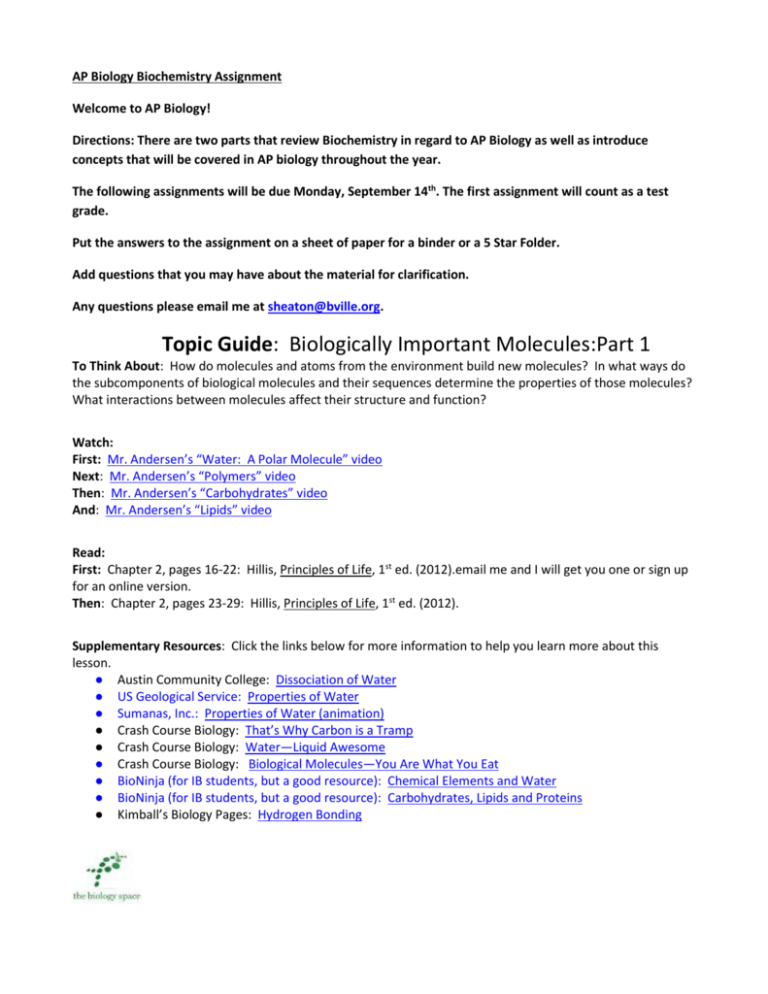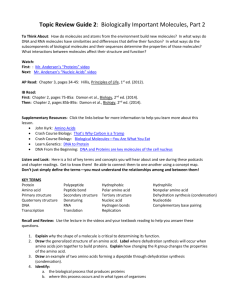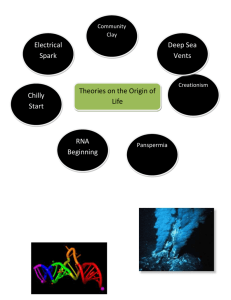Summer Assignment
advertisement

AP Biology Biochemistry Assignment Welcome to AP Biology! Directions: There are two parts that review Biochemistry in regard to AP Biology as well as introduce concepts that will be covered in AP biology throughout the year. The following assignments will be due Monday, September 14th. The first assignment will count as a test grade. Put the answers to the assignment on a sheet of paper for a binder or a 5 Star Folder. Add questions that you may have about the material for clarification. Any questions please email me at sheaton@bville.org. Topic Guide: Biologically Important Molecules:Part 1 To Think About: How do molecules and atoms from the environment build new molecules? In what ways do the subcomponents of biological molecules and their sequences determine the properties of those molecules? What interactions between molecules affect their structure and function? Watch: First: Mr. Andersen’s “Water: A Polar Molecule” video Next: Mr. Andersen’s “Polymers” video Then: Mr. Andersen’s “Carbohydrates” video And: Mr. Andersen’s “Lipids” video Read: First: Chapter 2, pages 16-22: Hillis, Principles of Life, 1st ed. (2012).email me and I will get you one or sign up for an online version. Then: Chapter 2, pages 23-29: Hillis, Principles of Life, 1st ed. (2012). Supplementary Resources: Click the links below for more information to help you learn more about this lesson. ● Austin Community College: Dissociation of Water ● US Geological Service: Properties of Water ● Sumanas, Inc.: Properties of Water (animation) ● Crash Course Biology: That’s Why Carbon is a Tramp ● Crash Course Biology: Water—Liquid Awesome ● Crash Course Biology: Biological Molecules—You Are What You Eat ● BioNinja (for IB students, but a good resource): Chemical Elements and Water ● BioNinja (for IB students, but a good resource): Carbohydrates, Lipids and Proteins ● Kimball’s Biology Pages: Hydrogen Bonding Listen and Look: Here is a list of key terms and concepts you will hear about and see during these podcasts and chapter readings. Get to know them! Be able to connect them to one another using a concept map. Don’t just simply define the terms—you must understand the relationships among and between them! KEY TERMS Polarity Polar Monomer Polymer Hydrophobic Hydrophilic Van der Waals interactions Ionic bonding Cohesion Organic Inorganic Hydrophobic interaction Covalent bond Hydrogen bond Hydrolysis Dehydration synthesis (condensation) Macromolecule Carbohydrate Monosaccharide Disaccharide Polysaccharide Lipid Nonpolar Amphipathic Phospholipid Triglyceride fat Saturated fat Unsaturated fat Recall and Review: Use the lecture in the videos and your textbook reading to help you answer these questions. 1. Create a t-chart that illustrates the difference between cohesion and adhesion of water molecules. Explain why each of these properties are significant to living things. 2. Create four cartoons that illustrate the properties of water that deal directly with hydrogen bonding. 3. Using a graphic organizer, explain how water’s high specific heat, high heat of vaporization and expansion upon freezing affect both aquatic and terrestrial ecosystems. 4. Describe how carbon skeletons may vary, and explain how this variation contributes to the diversity and complexity of organic molecules. 5. Explain how the letters of the alphabet are similar to monomers of a polymer. 6. Explain why the shape of a molecule is critical to determining its function. 7. Draw an example of two monomers forming a polymer through dehydration synthesis (condensation). 8. Explain the phrase “you are what you eat” in the context of dehydration synthesis and hydrolysis. 9. Create a graphic organizer that illustrates the structural and functional differences between the three types of carbohydrates. 10. Identify: a. the biological process that produces carbohydrates such as glucose, fructose and cellulose b. where this process occurs and in what types of organisms 11. Describe the hydrocarbon tail of a fatty acid. Explain why hydrocarbons are excellent sources of energy. 12. Draw a sketch of a saturated fatty acid and an unsaturated fatty acid, side by side. Explain how their respective structures influence their behavior in living cells. 13. Explain why the amphipathic quality of a phospholipid is ideal for the construction of cell membranes. 14. A friend of yours decides that they are going to cut all fat from their diet. Explain why such behavior could be detrimental to your friend’s health. Learn More: For more examples of biologically important molecules, use the links below: ● Kimball’s Biology Pages: Carbohydrates ● Kimball’s Biology Pages: Fats ● NobelPrize.org Chirality Game: learn about “handedness” of molecules ● University of California: Atoms, Molecules, Water, pH Topic Review Guide: Biologically Important Molecules: Part 2 To Think About: How do molecules and atoms from the environment build new molecules? In what ways do DNA and RNA molecules have similarities and differences that define their function? In what ways do the subcomponents of biological molecules and their sequences determine the properties of those molecules? What interactions between molecules affect their structure and function? Watch: First: : Mr. Andersen’s “Proteins” video Next: Mr. Andersen’s “Nucleic Acids” video Read: Chapter 3, pages 34-45: Hillis, Principles of Life, 1st ed. (2012). Supplementary Resources: Click the links below for more information to help you learn more about this lesson. ● John Kyrk: Amino Acids ● Crash Course Biology: That’s Why Carbon is a Tramp ● Crash Course Biology: Biological Molecules—You Are What You Eat ● Learn.Genetics: DNA to Protein ● DNA From the Beginning: DNA and Proteins are key molecules of the cell nucleus Listen and Look: Here is a list of key terms and concepts you will hear about and see during these podcasts and chapter readings. Get to know them! Be able to connect them to one another using a concept map. Don’t just simply define the terms—you must understand the relationships among and between them! KEY TERMS Protein Amino acid Primary structure Quaternary structure DNA Transcription Polypeptide Peptide bond Secondary structure Denaturing Hydrophobic Polar amino acid Tertiary structure RNA Translation Hydrogen bonds Replication Nucleic acid Hydrophilic Nonpolar amino acid Dehydration synthesis (condensation) Nucleotide Complementary base pairing Recall and Review: Use the lecture in the videos and your textbook reading to help you answer these questions 15. Explain why the shape of a molecule is critical to determining its function. 16. Draw the generalized structure of an amino acid. Label where dehydration synthesis will occur when amino acids join together to build proteins. Explain how changing the R group changes the properties of the amino acid. 17. Draw an example of two amino acids forming a dipeptide through dehydration synthesis (condensation). 18. Identify: a. the biological process that produces proteins b. where this process occurs and in what types of organisms 19. Create a 4-panel cartoon that illustrates the differences between the four levels of protein structure. 20. Explain how the environment surrounding a protein influence its shape and structure. 21. Explain the importance of hydrogen bonding in maintaining the structure of the nucleic acids DNA and RNA. 22. Explain the roles of DNA and RNA in making proteins. 23. Describe the similarities between ATP and nucleotides in DNA/RNA. 24. Explain how scientists think that DNA evolved from RNA and describe the bonds that hold the DNA molecule together. 25. Explain how DNA molecules can be so diverse even though they are structurally similar. Learn More: For more examples of biologically important molecules, use the links below: ● Foldit: play a game to practice folding proteins ● Eterna: play a game to design RNA molecules ● NobelPrize.org Chirality Game: learn about “handedness” of molecules









